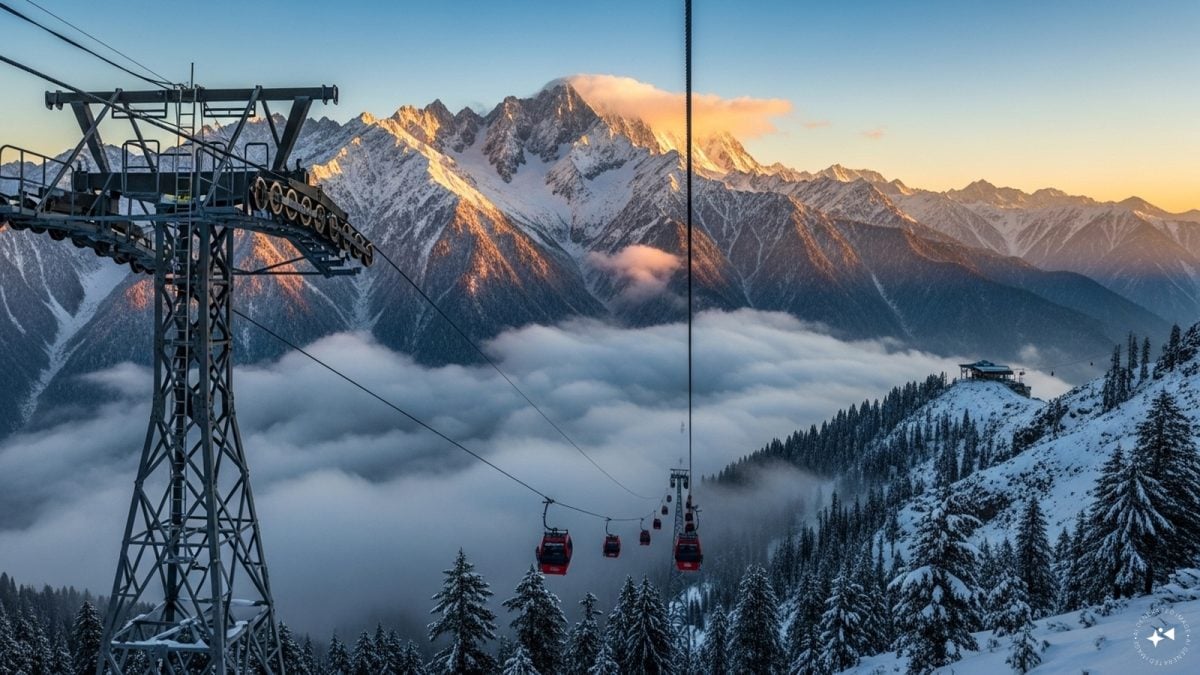Last Updated:
The official documents, seen by News18, included the list of six routes for each Tamil Nadu and Andhra Pradesh – highest among the states, followed by five in Jammu and Kashmir.

The National Highways Logistics Management Limited (NHLML) is planning 50 ropeway routes across 14 states and union territories. (AI generated image)
From the glacier-fed heights of Sonamarg and Amarnath in Jammu & Kashmir, to the serene hills of Ooty in Tamil Nadu and the cascading beauty of Athirapilly in Kerala, to the iconic summits of Kalsubai in Maharashtra and Hempeupet Peak in Assam – all these locations will soon have one thing in common: ropeway connectivity.
The National Highways Logistics Management Limited (NHLML) is planning 50 ropeway routes across 14 states and union territories.
Recommended Stories
At least ten Requests for Proposals (RFPs) for Detailed Project Reports (DPRs) have been floated over the past few weeks for ropeway development across Jammu and Kashmir, Himachal Pradesh, Rajasthan, Assam, Arunachal Pradesh, Uttarakhand, Telangana, Kerala, Maharashtra, Tamil Nadu, Madhya Pradesh, Chhattisgarh, Andhra Pradesh and Karnataka.
The official documents, seen by News18, included the list of six routes for each Tamil Nadu and Andhra Pradesh – highest among the states, followed by five in Jammu and Kashmir.
North Connect
In Jammu and Kashmir, the proposed stretches are Sonamarg – Thajiwas Glacier (2 km); Baltal-Amarnath Cave (12 km); Nasri Tunnel to Sanasar Ropeway (3 km); Bhaderwah to Seojdhar (9 km); and Doodpathri from Parihas to Diskhal (2 km).
In Uttarakhand, the routes included an 8 km stretch between Joshimath-Auli-Gorson; and four km between Raithal/ Barsu to Barnata, Uttarkashi.
In Himachal Pradesh, ropeways are proposed for Shirgul Mahadev Temple to Chudhar in Sirmou (8 km); Himani to Chamunda in Kangra (7 km); Bharmour to Bharmani Mata Temple (2 km); and Palampur Thatri – Chhunja Glacier (6 km).
South Connect
In Tamil Nadu, the proposed routes include one for Parvathamalai at Thiruvannamalai (3 km); Glenmorgan to Singara Power House in Ooty (5 km); Kurangani to Top Station (4 km); and Ropeway to Thoranamalai Murugan Temple (0.5 km). Two ropeways are planned for Sathuragiri Hill in Virudhunagar – 4 km and 0.5 km.
In Telangana, four routes are proposed – one km ropeway for Yadadarigutta Laxmi Narsimha Temple; 2 km between Nagarjunakonda and Nagarjunasagar dam; 2.4 km ropeway for Ramagiri fort in Manthani; and 1.2 km for Hanuman Hills Nalgonda.
The four routes in Kerala include 18 km stretch in Munnar; 3 km route between Pamba and Sannidhanam; 0.5 km ropeway for Athirapilly waterfalls; and 2 km stretch between Manapattuchira and Malayatoor.
A 32 km ropeway is proposed between Mannanur to Srisailam in Andhra
Pradesh – longest among the proposed routes. The other five routes for Andhra Pradesh are around 1 km each and mostly connect temples – Sri Boyakonda Gangamma Temple -Diguva Temple, Yeguva Ahobilam Temple-Jwala Narsimha Swamy Temple, old temple at Kotappa
Konda and Sri Lakshmi Narsimha Swamy temple. The plans are also to connect Berm Park to Bhavani Island across Krishna.
In Karnataka, only one route is proposed – about 4 km ropeway for Mullayyana Giri in Chickmagalur.
East, West & Centre
A 2 km ropeway is planned for Arunachal Pradesh for Parushram.
In Assam, a 3 km ropeway is proposed between Ganganagar Part-VII to Bhuban Pahar Mahadev Temple. Another 3.5 km ropeway is planned between Jatinga Bird Watching Tower and Hempeupet Peak. An 11 km ropeway between Khanapara and Lokopriya Gopinath Bordoloi International Airport, Guwahati is also proposed apart from a 2 km ropeway between Agnigarh Pahar and Bhairabi Mandir.
In Maharashtra, the routes included 1.4 km ropeway for Shivneri Fort, 3 km for Kanakeshwar and 2.5 km for Kalsubai Peak.
Close to 1 km ropeway is proposed in Chhattisgarh for Kudargarh. In Madhya Pradesh, the proposed routes are – of less than 1 km – for Salkanpur Wali Mata Mandir in Barkheda Salam; and Chauragarh Mahadev Mandir, Pachmarhi.
Jabalpur in Madhya Pradesh will get two ropeways – from Civic Centre to Baldev Bagh (2 km); and 8 km ropeway between Empire Talkies near Railway Station to Gurudwara covering Sadar Chouraha, Kantga, Rampur Chowk, South Avenue Mall, Gwarighat and Narmada river.
In Rajasthan, four routes will be explored – 6 km ropeway between Amer Fort and Nahargarh Fort via Jaigarh Fort in Jaipur; Jogi Mahal to Trinetra Ganesh Temple (1 km); Urban road near Vidhya Niketan School to Chittorgarh Fort (1 km); Bandariya Hanuman Temple – Samai Mata Temple (1 km).
The Plan
The Ministry will hire consultants through various tenders to carry out the DPR study for developing the ropeway system at each of the locations.
The study will include surveys – topographical, geotechnical, geodetic, avalanche (if required) for development of the project.
The work will also involve a detailed alignment plan for the ropeway for each project location and design key elements of the ropeway system from point of origin to destination including number of intermediate stations.
The length of the ropeway project mentioned in the plans is an estimate and may change based on detailed site assessments by the experts, a Ministry official told News18. The projects’ future, the official said, hinges on the DPR outcomes.
Small changes in the ropeway length, up to 20 per cent more or less, will not affect the project’s cost to the government.
“However, if the length changes by more than 20 per cent, it will lead to a review of the project scope and agreement to cover any additional costs or adjustments needed,” they said, demanding anonymity, adding that the picture is expected to become clear by year-end.
The finalisation of about 50 routes for DPR exemplifies the ambitious scale and transformative potential of India’s ropeway push. This widespread ropeway development drive, under the National Ropeways Development Programme known as Parvatmala Pariyojana, aims to revolutionise connectivity in India.
By facilitating safer, faster, and eco-friendly transport, the initiative also seeks to enhance tourism, deliver socio-economic benefits to remote communities, promote sustainable travel, and reduce road congestion and environmental impact.
If implemented as planned, the 50 proposed ropeways could redefine India’s mobility — connecting pilgrimage, tourism, and remote and urban regions like never before.
About the Author

Nivedita Singh is a data journalist and covers the Election Commission, Indian Railways and Ministry of Road Transport and Highways. She has nearly seven years of experience in the news media. She tweets @nived…Read More
Nivedita Singh is a data journalist and covers the Election Commission, Indian Railways and Ministry of Road Transport and Highways. She has nearly seven years of experience in the news media. She tweets @nived… Read More
October 06, 2025, 16:44 IST
Loading comments…
Read More



